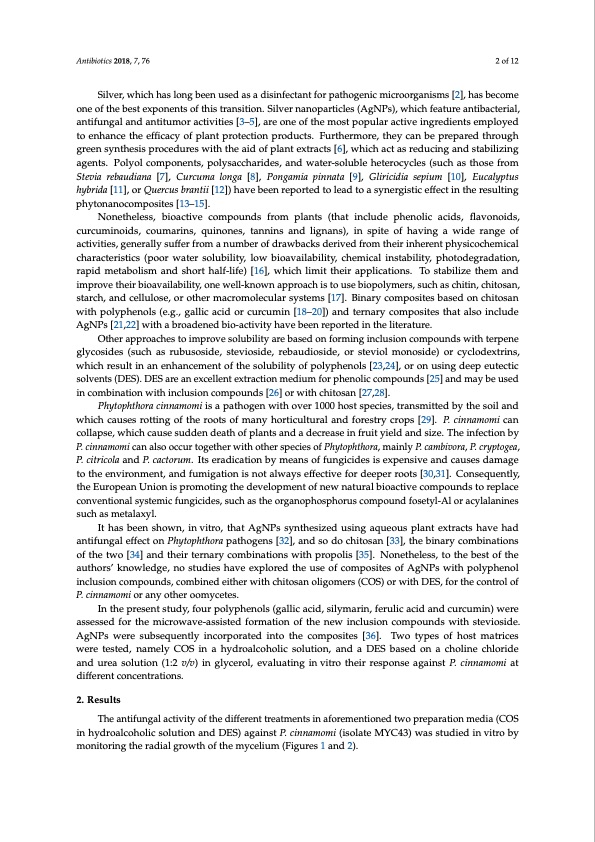
PDF Publication Title:
Text from PDF Page: 002
Antibiotics 2018, 7, 76 2 of 12 Silver, which has long been used as a disinfectant for pathogenic microorganisms [2], has become one of the best exponents of this transition. Silver nanoparticles (AgNPs), which feature antibacterial, antifungal and antitumor activities [3–5], are one of the most popular active ingredients employed to enhance the efficacy of plant protection products. Furthermore, they can be prepared through green synthesis procedures with the aid of plant extracts [6], which act as reducing and stabilizing agents. Polyol components, polysaccharides, and water-soluble heterocycles (such as those from Stevia rebaudiana [7], Curcuma longa [8], Pongamia pinnata [9], Gliricidia sepium [10], Eucalyptus hybrida [11], or Quercus brantii [12]) have been reported to lead to a synergistic effect in the resulting phytonanocomposites [13–15]. Nonetheless, bioactive compounds from plants (that include phenolic acids, flavonoids, curcuminoids, coumarins, quinones, tannins and lignans), in spite of having a wide range of activities, generally suffer from a number of drawbacks derived from their inherent physicochemical characteristics (poor water solubility, low bioavailability, chemical instability, photodegradation, rapid metabolism and short half-life) [16], which limit their applications. To stabilize them and improve their bioavailability, one well-known approach is to use biopolymers, such as chitin, chitosan, starch, and cellulose, or other macromolecular systems [17]. Binary composites based on chitosan with polyphenols (e.g., gallic acid or curcumin [18–20]) and ternary composites that also include AgNPs [21,22] with a broadened bio-activity have been reported in the literature. Other approaches to improve solubility are based on forming inclusion compounds with terpene glycosides (such as rubusoside, stevioside, rebaudioside, or steviol monoside) or cyclodextrins, which result in an enhancement of the solubility of polyphenols [23,24], or on using deep eutectic solvents (DES). DES are an excellent extraction medium for phenolic compounds [25] and may be used in combination with inclusion compounds [26] or with chitosan [27,28]. Phytophthora cinnamomi is a pathogen with over 1000 host species, transmitted by the soil and which causes rotting of the roots of many horticultural and forestry crops [29]. P. cinnamomi can collapse, which cause sudden death of plants and a decrease in fruit yield and size. The infection by P. cinnamomi can also occur together with other species of Phytophthora, mainly P. cambivora, P. cryptogea, P. citricola and P. cactorum. Its eradication by means of fungicides is expensive and causes damage to the environment, and fumigation is not always effective for deeper roots [30,31]. Consequently, the European Union is promoting the development of new natural bioactive compounds to replace conventional systemic fungicides, such as the organophosphorus compound fosetyl-Al or acylalanines such as metalaxyl. It has been shown, in vitro, that AgNPs synthesized using aqueous plant extracts have had antifungal effect on Phytophthora pathogens [32], and so do chitosan [33], the binary combinations of the two [34] and their ternary combinations with propolis [35]. Nonetheless, to the best of the authors’ knowledge, no studies have explored the use of composites of AgNPs with polyphenol inclusion compounds, combined either with chitosan oligomers (COS) or with DES, for the control of P. cinnamomi or any other oomycetes. In the present study, four polyphenols (gallic acid, silymarin, ferulic acid and curcumin) were assessed for the microwave-assisted formation of the new inclusion compounds with stevioside. AgNPs were subsequently incorporated into the composites [36]. Two types of host matrices were tested, namely COS in a hydroalcoholic solution, and a DES based on a choline chloride and urea solution (1:2 v/v) in glycerol, evaluating in vitro their response against P. cinnamomi at different concentrations. 2. Results The antifungal activity of the different treatments in aforementioned two preparation media (COS in hydroalcoholic solution and DES) against P. cinnamomi (isolate MYC43) was studied in vitro by monitoring the radial growth of the mycelium (Figures 1 and 2).PDF Image | Silver Nano Polyphenol Inclusion Compounds Composites

PDF Search Title:
Silver Nano Polyphenol Inclusion Compounds CompositesOriginal File Name Searched:
Silver_Nanoparticles_and_Polyphenol_Inclusion_Comp.pdfDIY PDF Search: Google It | Yahoo | Bing
Turbine and System Plans CAD CAM: Special for this month, any plans are $10,000 for complete Cad/Cam blueprints. License is for one build. Try before you buy a production license. More Info
Waste Heat Power Technology: Organic Rankine Cycle uses waste heat to make electricity, shaft horsepower and cooling. More Info
All Turbine and System Products: Infinity Turbine ORD systems, turbine generator sets, build plans and more to use your waste heat from 30C to 100C. More Info
CO2 Phase Change Demonstrator: CO2 goes supercritical at 30 C. This is a experimental platform which you can use to demonstrate phase change with low heat. Includes integration area for small CO2 turbine, static generator, and more. This can also be used for a GTL Gas to Liquids experimental platform. More Info
Introducing the Infinity Turbine Products Infinity Turbine develops and builds systems for making power from waste heat. It also is working on innovative strategies for storing, making, and deploying energy. More Info
Need Strategy? Use our Consulting and analyst services Infinity Turbine LLC is pleased to announce its consulting and analyst services. We have worked in the renewable energy industry as a researcher, developing sales and markets, along with may inventions and innovations. More Info
Made in USA with Global Energy Millennial Web Engine These pages were made with the Global Energy Web PDF Engine using Filemaker (Claris) software.
Infinity Turbine Developing Spinning Disc Reactor SDR or Spinning Disc Reactors reduce processing time for liquid production of Silver Nanoparticles.
| CONTACT TEL: 608-238-6001 Email: greg@infinityturbine.com | RSS | AMP |